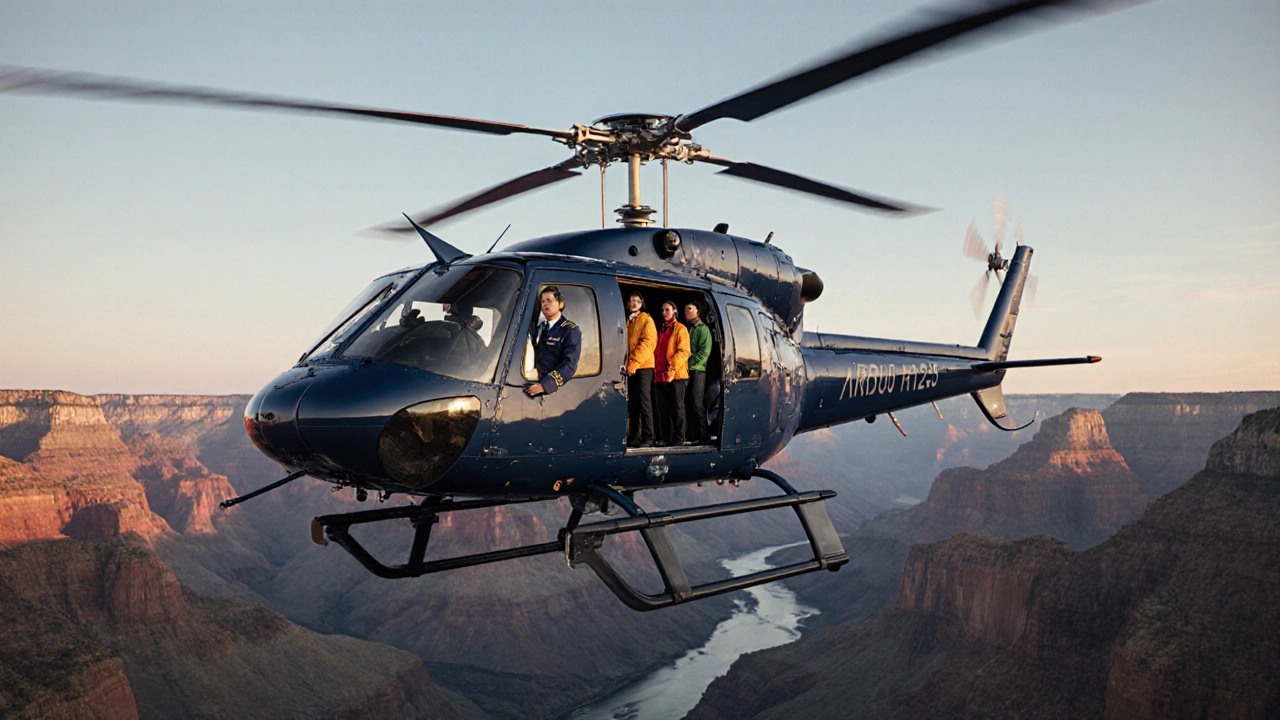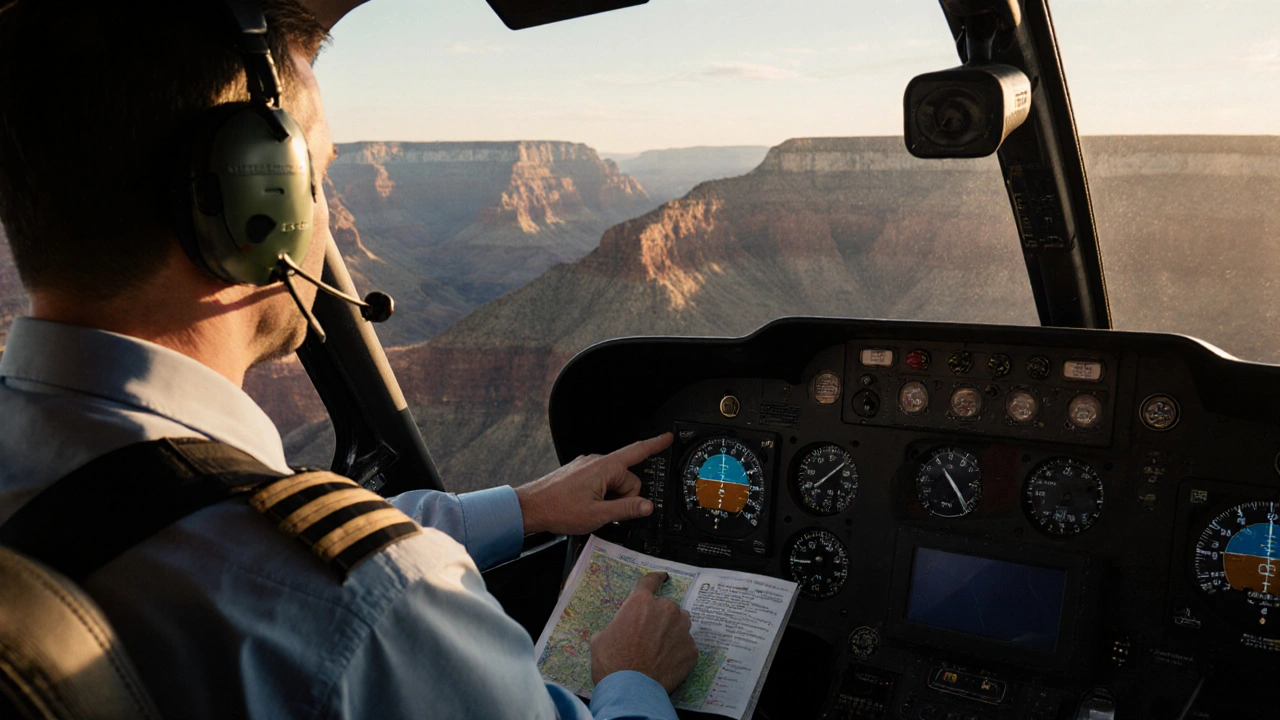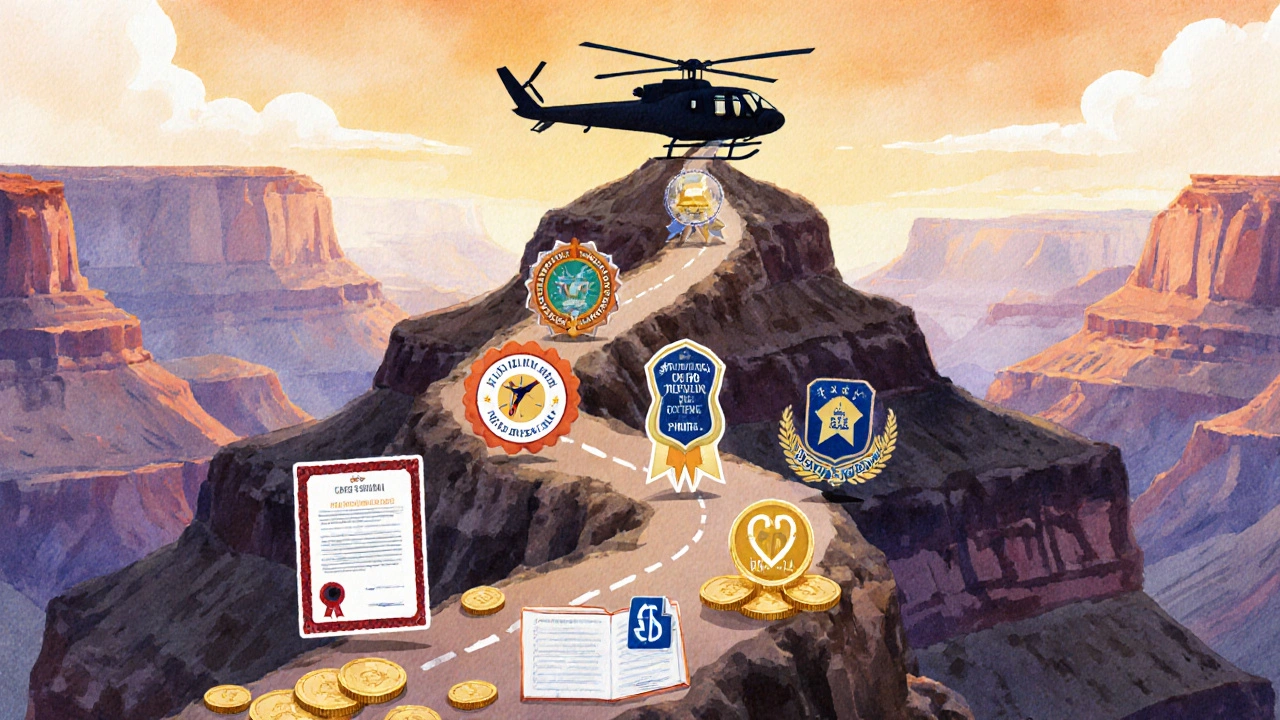Grand Canyon Helicopter Pilot Salary: How Much Do They Earn?

Grand Canyon Helicopter Pilot Salary Calculator
Calculate Your Earnings
Estimated Annual Compensation
Based on your inputs, your estimated total compensation is:
This includes base salary, bonuses for additional hours and certifications, and per-diem allowances.
Key Takeaways
- The average base pay for a Grand Canyon helicopter pilot hovers around $85,000 - $95,000 per year.
- Seasonal demand, flight‑hour totals, and FAA certifications can push total compensation above $120,000.
- Pilots working for larger tour outfits or flying premium aircraft earn the highest wages.
- Cost‑of‑living adjustments in Arizona keep take‑home pay competitive with national averages.
- Building flight hours, obtaining an ATP‑type rating, and negotiating per‑diem allowances are the quickest paths to a bigger paycheck.
When you hear the whir of rotor blades above the rim of the Grand Canyon, you’re probably thinking about the breathtaking views. Few realize the skilled crew that makes the experience possible. Grand Canyon helicopter pilot is a licensed aviator who operates commercial‑tour helicopters over the park, safely transporting tourists while narrating the landscape. The job blends high‑stakes flying with hospitality, and it comes with a pay scale that reflects that mix.
What Does a Grand Canyon Helicopter Pilot Actually Do?
The day starts early. Pilots check weather forecasts, file flight plans with the Federal Aviation Administration (FAA), and perform pre‑flight inspections on aircraft such as the Airbus H125 or the Bell 206. Once cleared, they lift off from launch sites like Grand Canyon Airport (GCN) or the West Rim heliport and guide up to 20 passengers on a 30‑minute aerial tour.
Beyond flying, pilots often act as tour guides, delivering facts about the geology, Native American history, and wildlife. This dual role means they must keep a calm cockpit while engaging an audience, a skill set that directly influences compensation.
Salary Landscape: Numbers You Can Trust
Nationally, the Bureau of Labor Statistics reports that helicopter pilots earn a median annual wage of $96,530 (2024). However, Grand Canyon tour pilots sit at a slightly different point due to regional demand and the tourism‑focused nature of the work.
Based on data from industry surveys (Heli‑Reports 2025) and salary aggregators such as Glassdoor and PayScale, here’s a snapshot of what pilots typically earn:
- Base salary: $85,000 - $95,000 per year.
- Overtime & per‑diem: $10,000 - $25,000 extra, depending on flight‑hour spikes during peak season (March-May and September-November).
- Total compensation: $95,000 - $120,000 for most full‑time pilots.
- Top earners: Up to $150,000+ for senior captains with 10+ years of experience, advanced certifications, and profit‑sharing agreements.
These figures assume a standard 40‑hour workweek. Many pilots work longer during high‑tourist months, which can boost earnings substantially.

Factors That Influence Pay
Understanding why salaries vary helps you target the highest‑paying opportunities. Below are the main drivers:
- Flight hours and experience: FAA regulations require a minimum of 1,000 total flight hours for commercial helicopter operations, but tour operators often prefer 2,000 + hours. Each additional 250‑hour block can add $2,000 - $4,000 to annual pay.
- Certifications: A Commercial Pilot License (CPL) is mandatory; an Instrument Rating (IR) and a Flight Instructor Certificate (CFI) are strong differentiators. The most lucrative positions ask for an Airline Transport Pilot (ATP)‑type rating, even though helicopters don’t have a formal “ATP” class; the equivalent advanced rating can boost salaries by 10‑15%.
- Aircraft type: Pilots flying newer, high‑performance models like the Airbus H125 (formerly the EC130) earn roughly $5,000 - $8,000 more than those on older Bell 206s, owing to higher insurance premiums and specialized training.
- Employer size: Large operators such as Maverick Helicopters and Papillon Airways often offer better benefits, profit‑sharing, and health packages compared to boutique outfits.
- Seasonality: Peak tourism months translate into higher overtime rates (often 1.5× base hourly pay). Off‑season pilots sometimes take a reduced schedule or supplement income with private charter work.
- Location cost‑of‑living: While Arizona’s cost of living is about 5% lower than the national average, pilots may receive a modest housing stipend that effectively raises take‑home pay.
Salary Comparison: Grand Canyon vs. Other Tour Hotspots
| Location | Base Salary (USD) | Typical Overtime/Per‑Diem | Total Compensation |
|---|---|---|---|
| Grand Canyon, AZ | $85,000 - $95,000 | $10,000 - $25,000 | $95,000 - $120,000 |
| Las Vegas, NV | $80,000 - $90,000 | $8,000 - $20,000 | $88,000 - $110,000 |
| Honolulu, HI | $90,000 - $100,000 | $12,000 - $30,000 | $102,000 - $130,000 |
| Juneau, AK | $78,000 - $88,000 | $9,000 - $22,000 | $87,000 - $110,000 |
While the Grand Canyon sits in the middle of the pack, its consistent tourist flow and relatively lower cost of living make it a stable choice for pilots seeking steady income.

Pathway to the Pilot’s Seat: Getting Hired
Here’s a step‑by‑step roadmap for aspiring tour pilots:
- Earn a high‑school diploma (or GED) and focus on math and physics.
- Enroll in an FAA‑approved aviation school. Complete a Private Pilot License (PPL) - about 40‑50 flight hours.
- Advance to a Commercial Pilot License (CPL); accumulate another 150‑200 flight hours.
- Obtain a helicopter rating (H) and log at least 1,000 total flight hours (including 100 hours of night flight for tour work).
- Earn an Instrument Rating (IR) and a Flight Instructor Certificate (CFI) to increase marketability.
- Apply to tour operators. Highlight any mountain‑flying experience, as high‑altitude operation is a plus.
- Complete a company‑specific safety and customer‑service training program (usually 2-4 weeks).
- Start as a first‑officer or junior captain, then work toward senior captain status, which unlocks profit‑sharing.
Many pilots also join the Helicopter Pilots Association (HPA) for networking and to stay updated on wage trends.
Tips to Maximize Earnings
- Negotiate per‑diem rates: Some operators reimburse meals and lodging at $60‑$80 per day; ensure this is factored into your contract.
- Pick up private charter gigs: Off‑season, many pilots fly corporate or sightseeing charters that pay $150‑$200 per hour.
- Seek senior‑captain roles: Profit‑sharing can add $10,000‑$20,000 yearly.
- Stay current on certifications: Adding a Night Vision Goggles (NVG) endorsement can increase hourly rates by 5%.
- Consider union membership: Pilots in unionized companies often enjoy better wage scales and health benefits.
By strategically stacking these levers, a pilot can push total compensation well above the $120,000 threshold.
Frequently Asked Questions
How many flight hours are required to become a Grand Canyon helicopter tour pilot?
The FAA mandates a minimum of 1,000 total flight hours for commercial helicopter work, but most tour operators prefer 2,000‑plus hours, especially with mountain‑flying experience.
Do pilots get tips from passengers?
Tips are rare on commercial tours because the fare already includes service fees. However, pilots sometimes receive a small gratuity during private charters.
What is the typical work schedule during peak season?
Pilots often work 8‑10 hour days, six days a week, with occasional early‑morning flights to catch sunrise tours.
Are there any health requirements?
Yes. Pilots must pass a Class 1 medical exam, meet vision standards (20/20 or correctable), and have no disqualifying cardiovascular issues.
How does cost‑of‑living affect take‑home pay?
Arizona’s cost of living is about 5% lower than the U.S. average, meaning a $100,000 salary stretches further on housing, groceries, and taxes compared to coastal states.
Whether you’re eyeing a cockpit view of the canyon or simply curious about the paycheck, the numbers above give a clear picture of what a Grand Canyon helicopter pilot earns today. With the right experience, certifications, and a strategic approach to overtime and private work, pilots can turn a solid baseline salary into a truly rewarding career.
Those numbers look solid for anyone eyeing the cockpit.
The article really breaks down the pay scale for canyon pilots.
It shows how experience and certifications can push the numbers up.
I love how it mentions the Airbus H125 versus the older Bell models.
The seasonal overtime numbers are eye‑opening.
Getting 2,000 flight hours seems like a daunting but rewarding goal.
The tip about per‑diem negotiations is something many overlook.
Cost‑of‑living adjustments in Arizona make the salary stretch further.
The table comparing other destinations helps put the figures in context.
I think the roadmap for aspiring pilots is clear and practical.
The mention of joining the Helicopter Pilots Association is useful.
The FAQ section answers common doubts nicely.
Overall the piece feels thorough and accessible.
It could have added more on health requirements but still solid.
For anyone considering a tour pilot career this is a great start.
The tone is neutral and the data seems reliable.
I will definitely bookmark this for future reference.
Look they don’t tell you that big tour companies are secretly owned by offshore investors who set the overtime rates to keep pilots dependent.
That’s why the per‑diem numbers look good on paper but disappear in hidden fees.
The FAA data they cite is often filtered through the same lobbyists.
It’s no coincidence the same airlines get the best contracts in the canyon.
If you dig deeper you’ll see a pattern of profit‑sharing that benefits only the top tier.
That’s why building flight hours is marketed as a path to freedom but actually locks you into their system.
Stay skeptical and read the fine print.
Don’t let glossy tables blind you.
Honestly i read this article and i felt it was pretty much the same old fluff you see everywhere about helicopter pilots.
the numbers are there but the piece drags on with the same generic bullet points.
i mean the whole "step‑by‑step" roadmap is just copy paste from any flight school brochure.
also the table comparing locations feels rushed and i doubt the exact figures are accurate.
you could have at least added some real pilot testimonials instead of this bland corporate tone.
the FAQ section repeats what any basic FAA site already says, nothing new.
maybe a deeper dive into the night‑vision goggles endorsement would have added value.
overall, decent for a quick skim but not worth a deep read.
Great rundown! If you’re aiming for a senior captain spot, remember that networking with current crew members can open doors faster than certifications alone.
Also, negotiate your per‑diem upfront – many operators are flexible during hiring season.
Keep logging those extra night‑vision hours; they’re a real paycheck booster.
The salary figures are eye‑opening and the breakdown of factors like flight hours and aircraft type really helps plan a career path.
What stands out to me is how the cost‑of‑living in Arizona positively impacts take‑home pay compared to coastal locations.
For anyone weighing options between the Grand Canyon and places like Honolulu, this article offers clear data to make an informed choice.
I appreciate the thoroughness of the analysis and the professional tone maintained throughout.
The inclusion of concrete numbers alongside actionable advice on certifications and per‑diem negotiations adds considerable value for prospective pilots.
Good info. Helpful for anyone thinking about the job.
Wow, reading this feels like soaring over the canyon itself-thrilling and a bit overwhelming!
The way the article layers salaries, bonuses, and certifications really paints a vivid picture of the pilot’s journey.
It makes me imagine the sunrise flights and the rush of the rotor blades beneath the sky.